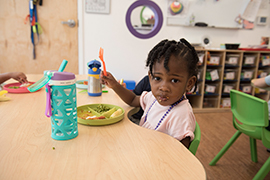Spotlight:
Celeste Joyner, Children’s College, Baltimore, MD
The Problem:
Two vegetarians, one pescatarian (who eats fish but no other meat), five omnivores. How does one provider feed such a diverse group of eaters?
Celeste Joyner, Children’s College, Baltimore, MD
Two vegetarians, one pescatarian (who eats fish but no other meat), five omnivores. How does one provider feed such a diverse group of eaters?
Topics: Family Stories, Best Practices, Health & Safety
Continue ReadingAs you cross off important items on your family’s back-to-school checklist, don’t forget to be proactive in learning more about the emergency plan at your child’s school or child care program. All schools and before/afterschool child care programs should have an emergency plan in place to prevent, prepare for, respond to, and recover from emergency situations, such as fires, natural disasters (tornadoes, hurricanes, wildfires, etc.), bomb threats, and dangerous intruders. Ask your child’s teacher or school administrator for details about their plan, and seek clarifications if you do not fully understand components of the plan.
Topics: Systems Building, Best Practices, Parenting, Health & Safety, emergency preparedness
Continue Reading It’s hard to believe that July is coming to a close, and with it the imminent start to a new school year! August is National Back to School Month and we are celebrating with parents and providers through our Back to School Blog Series and daily back to school tips. July was another busy month, which included the release of our 2017 State Fact Sheets. We also continue planning around the 2017 Leadership Institute in October and our culmination 30th anniversary celebration at 2018 Symposium in April.
It’s hard to believe that July is coming to a close, and with it the imminent start to a new school year! August is National Back to School Month and we are celebrating with parents and providers through our Back to School Blog Series and daily back to school tips. July was another busy month, which included the release of our 2017 State Fact Sheets. We also continue planning around the 2017 Leadership Institute in October and our culmination 30th anniversary celebration at 2018 Symposium in April.
Topics: Business Operations for CCR&Rs, Systems Building, Best Practices, News
Continue ReadingHave you ever had a child in your child care program not arrive by her usual arrival time and simply rationalized that the child must be sick or on vacation today? My mission is to show you how this assumption can have lethal consequences for dozens of young children annually.
How? Each year since 1998, an average of 37 children have perished due to what is known as vehicular heatstroke, also referred to as vehicular hyperthermia or child hot car deaths. At the time of this blog, 23 cases have been documented in 2017, and more than 723 since 1998.
Topics: Best Practices, Health & Safety
Continue ReadingTopics: Workforce, Best Practices, News
Continue ReadingStates need a way to measure whether their current child care licensing standards do or do not meet the Caring for Our Children Basics (CFOC Basics) guidelines. Those are the minimum health and safety standards that child care programs should meet.
Topics: Systems Building, Best Practices, Health & Safety
Continue Reading
Child Care Aware® of America is a not-for-profit organization recognized as tax-exempt under the internal revenue code section 501(c)(3) and the organization’s Federal Identification Number (EIN) is 94-3060756.
Child Care Aware® of America is a not-for-profit organization recognized as tax-exempt under the internal revenue code section 501(c)(3) and the organization’s Federal Identification Number (EIN) is 94-3060756.